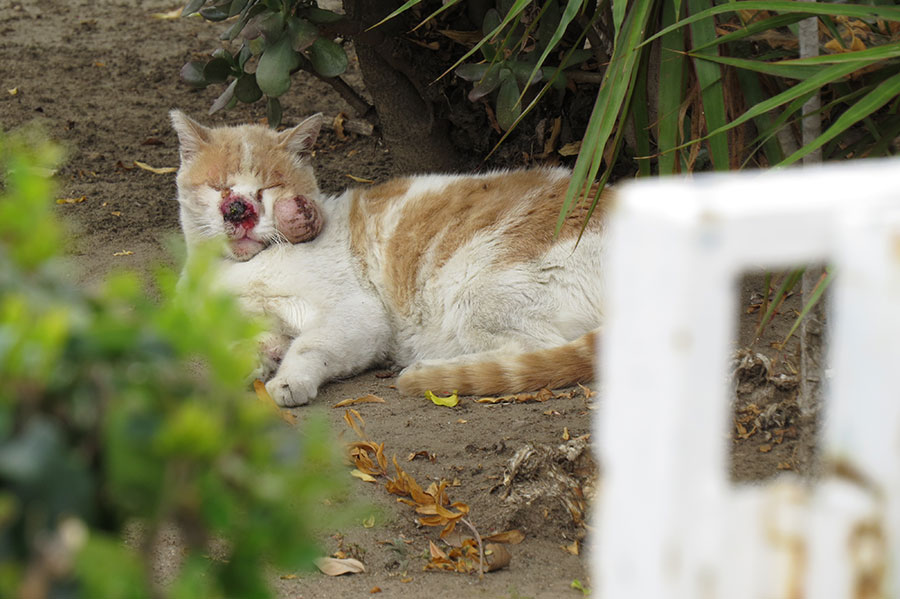It’s estimated that 60 to 100 million feral cats roam freely in America’s parks, parking lots, backyards, and alleys. These cats, descendants of abandoned and unaltered domestic cats, may have little to no contact with humans. As members of a domesticated species, they struggle to survive in the wild. Feral cats rarely die of natural causes. Instead, they fall victim to poisoning, shootings, malicious human activities, other animals, vehicle accidents, exposure, starvation, or highly infectious diseases such as rabies, feline AIDS, feline leukemia, and feline infectious peritonitis.
The Harsh Reality for Feral Cats
The existence of feral cats is marked by hardship. They often endure brutal treatments by humans and suffer from easily treatable conditions that can become life-threatening due to lack of medical attention. Untreated wounds and infections, upper-respiratory complications, ear mites, blood loss from fleas and worms, and untreated urinary-tract infections can all lead to suffering and death.
Moreover, feral cats can pose serious threats to local wildlife. For instance, in 2002, a group of feral cats nearly wiped out a colony of rare native Hawaiian seabirds, killing nearly 100 birds within two weeks.
Feeding Is Not Enough
While feeding feral cats may seem like an act of kindness, it could exacerbate the problem if not accompanied by efforts to capture and spay or neuter these animals. Food can enable more reproduction, leading to increased suffering and death among the kittens. Therefore, feeding should only be a precursor to trapping, acclimating the cats to eating at a specific place and time.
Best Practices for Trapping Feral Cats
Before attempting to trap feral cats, ensure you have written permission from the property owner where the cats are located. Always wear thick gloves for your safety and the cat’s, and handle the trap gently to minimize stress for the cat.
Make sure the trap is lined with cloth, newspaper, or an old towel to provide some comfort. Never leave the trap unattended and always place it on firm, level ground. Use appealing food as bait and immediately cover the trap once a cat enters to help calm the animal.
When transporting the trapped cat, move gently and quietly to reduce stress. Plan in advance where you’ll take the cat after capture. Ideally, this should be a veterinarian or animal shelter where they can be neutered or spayed, vaccinated, and treated for any health issues.
If bringing the cat home from the vet, provide a quiet space separated from other animals for a week or two. This allows them to recover from surgery and adjust to their new environment. Keep in mind, acclimating a feral cat to a new home can take months or even years of patience and kindness.
In severe cases, the most compassionate choice may be to euthanize the cat. This should be a last resort and only considered if there is a severe shortage of homes, socialization challenges, or extreme danger. It’s crucial to remember that a humane death is often kinder than the harsh realities a feral cat faces in the wild.
Obtaining a Trap
If your local animal shelter does not provide a box trap, consider purchasing one from a reliable supplier such as Animal Care Equipment & Services, Inc. (ACES), Heart of the Earth Marketing, or Tomahawk Live Trap Co. These traps typically cost between $40 and $50.
Our collective efforts in trapping, neutering, and providing medical treatment for feral cats can prevent their suffering and better manage their populations, creating safer environments for both the cats and the wildlife they affect.
References:
1. Jessup, D. A., “The welfare of feral cats and wildlife,” Journal of the American Veterinary Medical Association, 2004.
2. John Tuohy, “Man Fined in Shooting Death of Cat,” Florida Today, 3 Jul. 1999.
3. Ed Treleven, “Cruelty Charge to Be Dropped in Beating Death of Feral Cat; District Attorney Feels Jury Would Decide Fish Hatchery Director’s Action Was Justified,” Wisconsin State Journal, 23 Mar. 2002.
4. Pat Omandam, “Cat Lovers Upset at UH Treatment of Feral Felines,” Honolulu Star-Bulletin, 25 Sep. 1998.
5. Timothy Hurley, “Cats Suspected in Sea-Bird Kill on Maui,” The Honolulu Advertiser, 9 Aug. 2002.
6. Lawrence G. Proulx, “Free-Ranging Felines Fall Prey to Their Own Survival Skills,” The Washington Post, 3 Mar. 1997.

